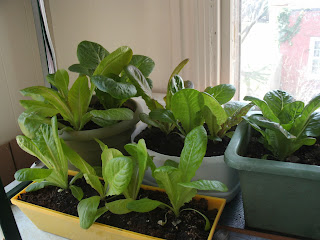#'s Interesting Garden Numbers #'s
How many family food dollars can be saved by even a small urban garden?
Some years ago, Lois and I recognized that we had space for a garden and that garden might include more than just flowers. The space, however, was, at that time, occupied by a pair of double car roofed garages and a 20 foot paved space between them. In reality 90% of our "yard" was a concrete floor surrounded by walls sloping from 10 feet high down to 8 feet. It took us a month to demolish and remove the roof system and heavy wooden door systems. Then we installed a 20 foot wide, 6 foot high fence across the parking pad opening. Now we were ready to build a patio area and the raised garden bed area.
For the garden area, I began by buying 9 pieces of 8"x8"x8' treated timbers to construct the first"box", the rear of which was the "garage" wall. Then I had the good luck to be able to salvage about 250 linear feet of used 8x8x8 treated lumber being removed from a spot downtown to expand a parking lot. This addition brought the main box to its full size of approximately 200 square feet. A second box was constructed with the remainder of the salvaged lumber and measures 3'x12'. It's primarily used for strawberries and flowers.
March, 2003
Filling the boxes with topsoil was quite another adventure altogether. Although there is a lane next to our house, it isn't wide enough to accommodate a truck. The topsoil to fill the boxes had to be carried in by hand! We didn't have a truck, so we began by loading the car with bags. At one point we paid for a delivery of 60 bags to the street in front of our house. A friend with a pickup truck also helped us by bringing a load of 40 bags. Ultimately, we brought in 303 bags of topsoil at 40 pounds per bag - 12,120 pounds or 6+ tons of topsoil!
June, 2005
Has it been worth it? Absolutely! Gardening gives joy, teaches patience, and, at times, makes us deal with disappointment. And it's good physical exercise! But I also believe there's an excellent economic benefit. In the past 3 years, I've weighed every ounce of raw produce that we've brought in from the garden (you're correct, I am crazy). In 2010, the total was 312 pounds. In 2011, the total was 313 pounds. In 2012, our total fell off to a mere 309 pounds! Nearly a
half ton of produce over 3 seasons! We used only organic fertilizers and no commercial pesticides - just homegrown care and lots of compost. And we used what we grew. If we didn't eat it as it came into the kitchen, we prepared and froze it in vacuum sealed bags.
What does the average pound of organic produce cost at the store where you shop? I'll use $2.50 as an
average number for the store bought cost of a pound of organic produce. At $2.50/lb. our total "grocery" produce value over the past 3 years is $2,335! That's a lot of food store savings!
Are there offsets to that number? Yes, and I would estimate that it comes to about $150 yearly and most of that cost is for water in midsummer dry spells.
October, 2007
Now's the time to start your garden planning and getting your space ready. You'll soon be planting fresh homegrown food you can trust while saving money....that's a great combination!
******
Mike B asks the question "
Why do you recommend Jet Star tomatoes?" in my 3/11 post. A while back, we visited a place called the "Tomato Barn" in western Lancaster County near the Susquehanna River. The exclusively sell "Jet Star" and we REALLY liked them. They're medium/large & nicely round with great color outside and inside, excellent flavor, and very small internal stem core. Plants are very productive and have a long season. They aren't the only great tomatoes out there, but it's our current favorite.
The Frugal Gardener's Tip: Eggshells are a helpful garden soil amendment. Rinse the inside of your broken eggshells in warm water. Dry the shells, making sure all of the albumen (egg white) is removed. Place the shells in your microwave on high for a minute. If you failed to clean the inside of the shells, you will have a very smelly kitchen. Trust me, I know from personal experience! Remove the shells from the microwave carefully...they will be HOT. After cooling, smash the shells with a rolling pin or other flat kitchen utensil. Sprinkle the shells around your garden plants to add a little extra calcium to your soil. And, of course, you can simply skip all of the above and just mash the fresh wet shells as the are, but they will remain in larger pieces rather than finely ground shells .
P.S. to my 3/11/13 post - Regarding creating your compost heap, kitchen scraps are certainly wanted, but meat waste should never be added to the compost. The addition of meat would create an attraction to wild animals you most likely would not want in your garden.
P.S. to 3/11/13 post - When turning over your compost, use your shovel or a garden fork gently to avoid harming the many earthworms your heap will have attracted.
Thanks for stopping by. I hope to see you again soon! Comments and your garden tips are always welcome.
chuckscards42@hotmail.com or
http://chucksgardenspot.blogspot.com

















